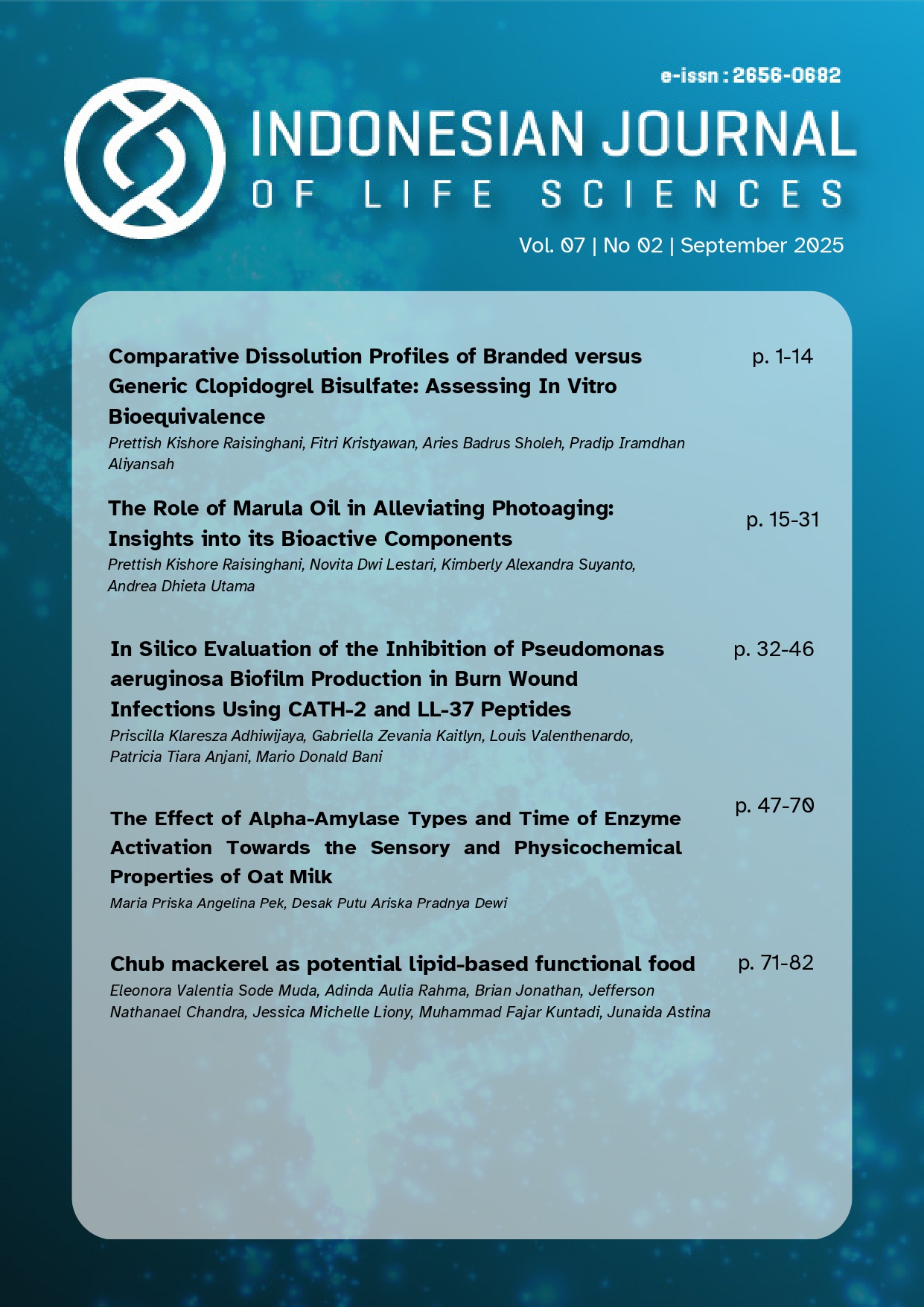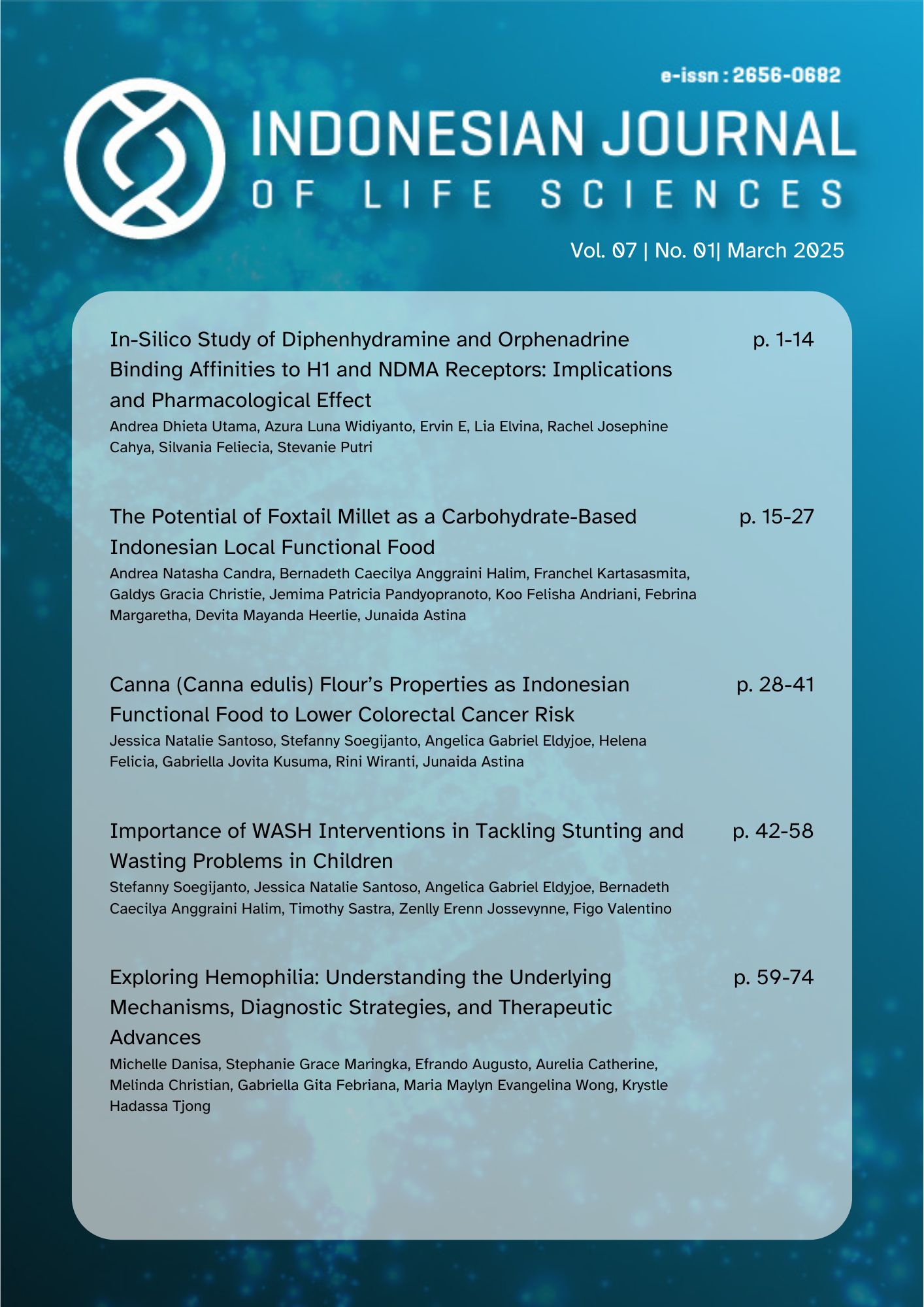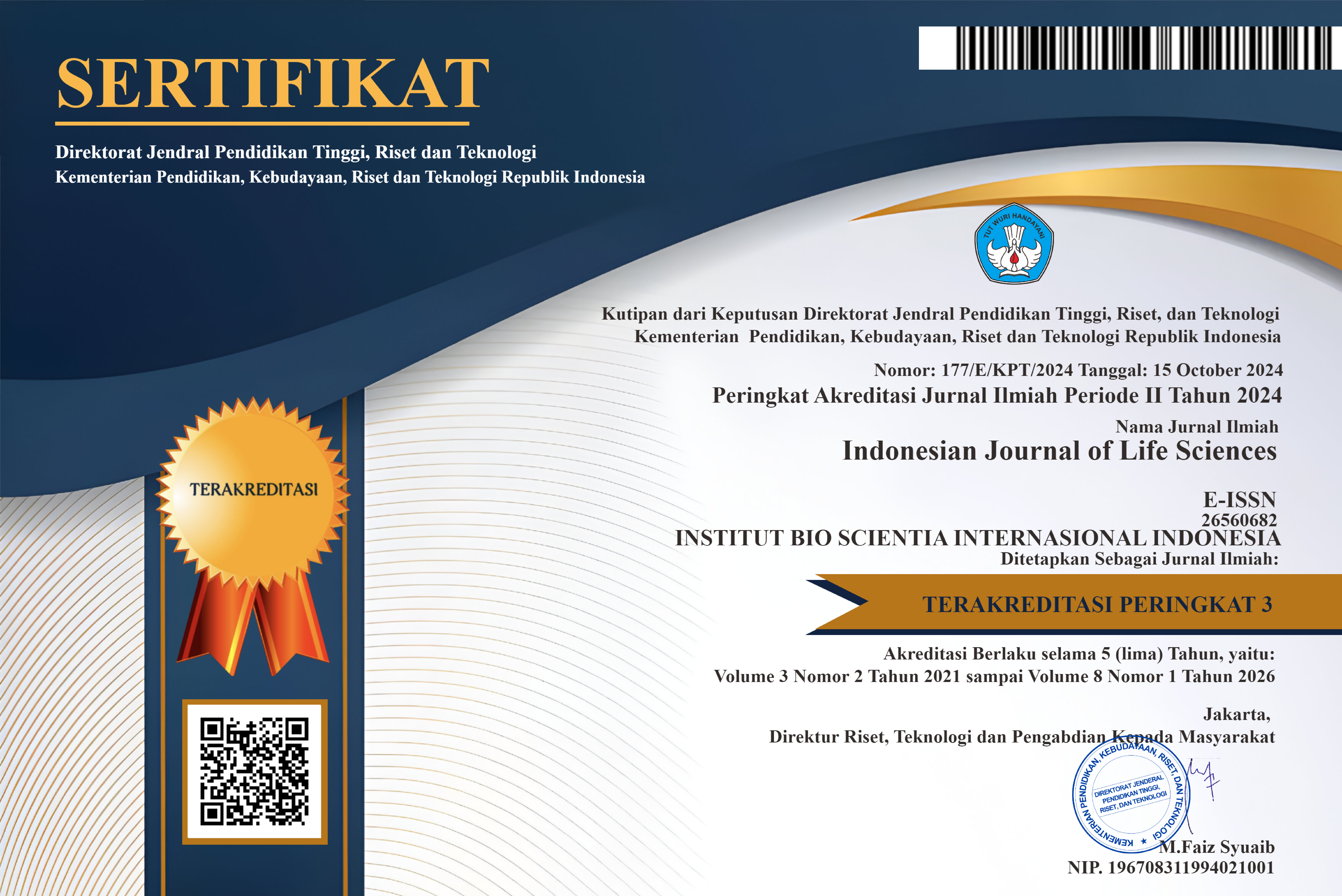The Effect of Alpha-Amylase Types and Time of Enzyme Activation Towards the Sensory and Physicochemical Properties of Oat Milk
Abstract
Plant-based or non-dairy milk substitutes are becoming favored in the growing field of functional beverages driven by factors such as health benefits, allergies, lactose intolerance, and the rise in vegan diets. However, there are challenges to producing oat milk, such as achieving the desirable texture and taste. This study is aimed to have 4 treatments utilizing 2 different kinds of amylase (Amylase 1 and Amylase 2) along with 2 different times of enzymatic activation (20 minutes and 30 minutes) to modify physicochemical properties and sensory qualities. This process includes the utilization of 2 amylase enzyme brands, guar gum, canola oil, and oat flour which improves the overall quality of this alternative to dairy milk. Oat milk making involves combining water, oat flour, and oil. The mixture was then processed until smooth before filtration and amylase was added for an enzymatic reaction. The mixture was then pasteurized, and finally, guar gum solution was stirred in before serving. This research investigates the physicochemical characteristics and sensory qualities of enzymatic oat milk, encompassing pH, brix, stability, viscosity, 5-point hedonic test, and rank test. Moreover, it was found that there are significant differences in all of the attributes including pH, brix, viscosity, and stability with the p-value of less than 0.001. It was also found that the time of enzymatic activation had no impact towards the physicochemical and sensorial properties of oat milk. Lastly, sensorial properties of the oat milk prepared with amylase enzymes scored higher in all attributes compared to the negative control.
Keywords: Oat milk, amylase, activation time, sensory, physicochemical
Downloads
References
Alemayehu, G. F., Forsido, S. F., Tola, Y. B., & Amare, E. (2023). Nutritional and phytochemical composition and associated health benefits of oat (Avena sativa) grains and oat-based fermented food products. The Scientific World Journal, 2023, 1–16. https://doi.org/10.1155/2023/2730175
Alsado, C., Lopez-Aldana, L., Chen, L., & Wismer, W. (2023). Consumer perception and sensory drivers of liking of fortified oat milks. Foods, 12(22), 4097. https://doi.org/10.3390/foods12224097
Akinfemiwa, O., Zubair, M., & Muniraj, T. (2023). Amylase. StatPearls. https://www.ncbi.nlm.nih.gov/books/NBK557738/
Andrade, E. F., Vieira Lobato, R., Vasques de Araújo, T., Zangerônimo, M. G., Sousa, R. V. D., & Pereira, L. J. (2015). Efecto de los beta-glucanos en el control de los niveles de glucosa en pacientes diabéticos: revisión sistemática. Nutrición Hospitalaria, 31(1), 170-177. https://doi.org/10.3305/nh.2015.31.1.7597
Andrade C. (2019). The P Value and Statistical Significance: Misunderstandings, Explanations, Challenges, and Alternatives. Indian journal of psychological medicine, 41(3), 210–215. https://doi.org/10.4103/IJPSYM.IJPSYM_193_19
Arilla, E., Martínez-Monzó, J., Chiş, M. S., Fǎrcaş, A. C., Socaci, S. A., Codoñer-Franch, P., García-Segovia, P., & Igual, M. (2023). Sensory Evaluation, Physico-Chemical Properties, and Aromatic Profile of Pasteurised Orange Juice with Resistant Maltodextrin. Foods (Basel, Switzerland), 12(21), 4025. https://doi.org/10.3390/foods12214025
Aydar, E. F., Tutuncu, S., & Ozcelik, B. (2020). Plant-based milk substitutes: Bioactive compounds, conventional and novel processes, bioavailability studies, and health effects. Journal of Functional Foods, 70, 103975. https://doi.org/10.1016/j.jff.2020.103975
Aydogdu, T., O’Mahony, J. A., & McCarthy, N. A. (2022). Measurement of ph at high temperature in milk protein solutions. International Dairy Journal, 131. https://doi.org/10.1016/j.idairyj.2022.105383
Aydogdu, T., O’Mahony, J. A., & McCarthy, N. A. (2023). Ph, the fundamentals for milk and Dairy Processing: A Review. Dairy, 4(3), 395–409. https://doi.org/10.3390/dairy4030026
Babolanimogadam, N., Gandomi, H., Akhondzadeh Basti, A., & Taherzadeh, M. J. (2022). Nutritional, functional, and sensorial properties of oat milk produced by single and combined acid, alkaline, α-amylase, and sprouting treatments. Food Science & Nutrition, 11(5). https://doi.org/10.1002/fsn3.3171
Bao, L., Cai, X., Xu, M., & Li, Y. (2014). Effect of oat intake on glycaemic control and insulin sensitivity: A meta-analysis of randomised controlled trials. British Journal of Nutrition, 112(3), 457-466. https://doi.org/10.1017/s0007114514000889
Barcchiya, J., Meena, R. K., & Lal, N. (2017). Oat is a multifunctional cereal crop. Innov. Farming, 2, 114-116. https://www.researchgate.net/profile/Rupesh-Meena/publication/348370451_OAT_IS_A_MULTIFUNCTIONAL_CEREAL_CROP/links/5ffb1d1992851c13fe02d42d/OAT-IS-A-MULTIFUNCTIONAL-CEREAL-CROP.pdf
Battilana, P., Ornstein, K., Minehira, K., Schwarz, J. M., Acheson, K., Schneiter, P., & Tappy, L. (2001). Mechanisms of action of β-glucan in postprandial glucose metabolism in healthy men. European journal of clinical nutrition, 55(5), 327-333. https://doi.org/10.1038/sj.ejcn.1601160
Benmeziane, F., & Belleili, I. (2023). An innovative approach: Formulation and evaluation of fermented oat milk using native yoghurt cultures. Measurement: Food, 12, 100113. https://doi.org/10.1016/j.meafoo.2023.100113
Carabante Ordonez, K. M. (2017). Statistical and Technical Methodologies for Duplicated Multiple-Samples Preference and Attribute Intensity Sensory Ranking Test. https://repository.lsu.edu/gradschool_dissertations/4141/
Considine, J. A., & Frankish, E. (2023). A complete guide to quality in small-scale wine making. Academic Press. https://doi.org/10.1016/C2021-0-01935-0
Cordeiro, C. A., Martins, M. L., & Luciano, A. B. (2002). Production and properties of alpha-amylase from thermophilic bacillus sp.. Brazilian Journal of Microbiology, 33(1). https://doi.org/10.1590/s1517-83822002000100012
Cui, L., Jia, Q., Zhao, J., Hou, D., & Zhou, S. (2023). A comprehensive review on oat milk: From oat nutrients and phytochemicals to its processing technologies, product features, and potential applications. Food & Function, 14(13), 5858–5869. https://doi.org/10.1039/d3fo00893b
de Souza, P. M., & de Oliveira Magalhães, P. (2010). Application of microbial α-amylase in industry - A review. Brazilian journal of microbiology : [publication of the Brazilian Society for Microbiology], 41(4), 850–861. https://doi.org/10.1590/S1517-83822010000400004
Deswal, A., Deora, N. S., & Mishra, H. N. (2013). Optimization of enzymatic production process of oat milk using response surface methodology. Food and Bioprocess Technology, 7(2), 610–618. https://doi.org/10.1007/s11947-013-1144-2
Deziderio, M. A., de Souza, H. F., Kamimura, E. S., & Petrus, R. R. (2023). Plant-Based Fermented Beverages: Development and Characterization. Foods (Basel, Switzerland), 12(22), 4128. https://doi.org/10.3390/foods12224128
Dhankhar, J., & Kundu, P. (2021). Stability aspects of non-dairy milk alternatives. Milk Substitutes - Selected Aspects. https://doi.org/10.5772/intechopen.96376
Dodge, Y. (2008). The concise encyclopedia of statistics: With 247 tables. Springer. http://dx.doi.org/10.1007/978-0-387-32833-1
Eisinga, R., Heskes, T., Pelzer, B., & Te Grotenhuis, M. (2017). Exact p-values for pairwise comparison of Friedman rank sums, with application to comparing classifiers. BMC bioinformatics, 18(1), 68. https://doi.org/10.1186/s12859-017-1486-2
EFSA. (2011). Scientific opinion on the substantiation of health claims related to beta-glucans from oats and barley and maintenance of normal blood LDL-cholesterol concentrations (ID 1236, 1299), increase in satiety leading to a reduction in energy intake (ID 851, 852. EFSA Journal, 9(6), 2207. https://doi.org/10.2903/j.efsa.2011.2207
Emkani, M., Oliete, B., & Saurel, R. (2022). Effect of lactic acid fermentation on legume protein properties, a review. Fermentation, 8(6), 244. https://doi.org/10.3390/fermentation8060244
Ferranti, P. (2023). Sustainable Food Science: A comprehensive approach. ELSEVIER.
Fredrick, E. (2011). Fat crystallization and partial coalescence in dairy creams: Role of monoacylglycerols. S.n.
Frøst, M. B., Dijksterhuis, G., & Martens, M. (2001). Sensory perception of fat in milk. Food Quality and Preference, 12(5–7), 327–336. https://doi.org/10.1016/s0950-3293(01)00018-0
Geburt, K., Albrecht, E. H., Pointke, M., Pawelzik, E., Gerken, M., & Traulsen, I. (2022). A comparative analysis of plant-based Milk Alternatives Part 2: Environmental impacts. Sustainability, 14(14), 8424. https://doi.org/10.3390/su14148424
Greis, M., Sainio, T., Katina, K., Nolden, A. A., Kinchla, A. J., Seppä, L., & Partanen, R. (2022). Physicochemical Properties and Mouthfeel in Commercial Plant-Based Yogurts. Foods (Basel, Switzerland), 11(7), 941. https://doi.org/10.3390/foods11070941
Global Instruments. (2024). Digital hand-held “pocket” refractometer PAL-α. https://www.globalinstrumentsg.com/digital-hand-held-pocket-refractometer-pal-a
Guo, M. (2009). Functional foods: Principles and technology. CRC Press.
Jaywant, S. A., Singh, H., & Arif, K. M. (2022). Sensors and Instruments for Brix Measurement: A Review. Sensors (Basel, Switzerland), 22(6), 2290. https://doi.org/10.3390/s22062290
Jeske, S., Zannini, E., & Arendt, E. K. (2017). Evaluation of Physicochemical and Glycaemic Properties of Commercial Plant-Based Milk Substitutes. Plant foods for human nutrition (Dordrecht, Netherlands), 72(1), 26–33. https://doi.org/10.1007/s11130-016-0583-0
Jiang, J., Wu, H., Lu, Y., Ma, T., Li, Z., Xu, D., Kang, W., & Bai, B. (2018). Application of α-amylase as a novel biodemulsifier for destabilizing amphiphilic polymer-flooding produced liquid treatment. Bioresource Technology, 259, 349–356. https://doi.org/10.1016/j.biortech.2018.03.069
JoVE. (2024). Using a ph meter: Principles, calibration and PH measurement: General chemistry. https://www.jove.com/v/5500/using-a-ph-meter-principles-calibration-and-ph-measurement
Karimidastjerd, A., & Konuşkan, Z. G. (2021). Health Benefits of Plant-based Milks as Alternatives to Conventional Milk.
Karlsson, M. A., Langton, M., Innings, F., Malmgren, B., Höjer, A., Wikström, M., & Lundh, Å. (2019). Changes in stability and shelf-life of ultra-high temperature treated milk during long term storage at different temperatures. Heliyon, 5(9). https://doi.org/10.1016/j.heliyon.2019.e02431
Koyama, K., Shono, J., Taguchi, H., Toriba, A., & Hayakawa, K. (2013). Effect of starch on the inactivation of amylase in starch-containing foods. Food Science and Technology Research, 19(6), 989–993. https://doi.org/10.3136/fstr.19.989
Krampe, C., & Fridman, A. (2022). Oatly, a serious ‘problem’ for the dairy industry? A case study. International Food and Agribusiness Management Review, 25(1), 157–171. https://doi.org/10.22434/ifamr2021.0058
Kumar, L., Sehrawat, R., & Kong, Y. (2021). Oat proteins: A perspective on functional properties. Lwt, 152, 112307. https://doi.org/10.1016/j.lwt.2021.112307
Kumar, Y., Singh, P. K., Masih, H., Kiran, J., Peter, Benjamin, J. C., & Rath, S. (2014). Production Optimization of Alpha Amylase from Bacillus Altitudinis . International Journal of Scientific and Engineering Research, 3(4), 0564–0573.
Laerd Statistics. (2018). Friedman test in SPSS statistics. Friedman Test in SPSS Statistics - How to run the procedure, understand the output using a relevant example | Laerd Statistics. https://statistics.laerd.com/spss-tutorials/friedman-test-using-spss-statistics.php
Lal, S. N. D., O’Connor, C. J., & Eyres, L. (2006). Application of emulsifiers/stabilizers in dairy products of High Rheology. Advances in Colloid and Interface Science, 123–126, 433–437. https://doi.org/10.1016/j.cis.2006.05.009
Liu, J., & Xu, Y. (2022). T-friedman test: A new statistical test for multiple comparison with an adjustable conservativeness measure. International Journal of Computational Intelligence Systems, 15(1). https://doi.org/10.1007/s44196-022-00083-8
Liu, S., Li, Y., Obadi, M., Jiang, Y., Chen, Z., Jiang, S., & Xu, B. (2019). Effect of steaming and defatting treatments of oats on the processing and eating quality of noodles with a high oat flour content. Journal of Cereal Science, 89, 102794. https://doi.org/10.1016/j.jcs.2019.102794
Magwaza, L. S., & Opara, U. L. (2015). Analytical methods for determination of sugars and sweetness of horticultural products—a review. Scientia Horticulturae, 184, 179–192. https://doi.org/10.1016/j.scienta.2015.01.001
Martínez-Villaluenga, C., & Peñas, E. (2017). Health benefits of OAT: Current evidence and molecular mechanisms. Current Opinion in Food Science, 14, 26–31. https://doi.org/10.1016/j.cofs.2017.01.004
Marwati, T., Cahyaningrum, N., Widodo, S., Astiati, U. T., Budiyanto, A., Wahyudiono, Arif, A. B., & Richana, N. (2018). The effect of alpha amylase enzyme on quality of sweet sorghum juice for Chrystal Sugar. IOP Conference Series: Earth and Environmental Science, 102. https://doi.org/10.1088/1755-1315/102/1/012090
Mazumder, S. K., Das, S. K., Rahim, S. M., & Ghaffar, M. A. (2018). Temperature and diet effect on the pepsin enzyme activities, digestive somatic index and relative gut length of Malabar blood snapper (Lutjanus Malabaricus Bloch & Schneider, 1801). Aquaculture Reports, 9, 1–9. https://doi.org/10.1016/j.aqrep.2017.11.003
McCarron, R., Methven, L., Grahl, S., Elliott, R., & Lignou, S. (2024). Oat-based milk alternatives: The influence of physical and chemical properties on the sensory profile. Frontiers in Nutrition, 11. https://doi.org/10.3389/fnut.2024.1345371
McClements, D. J. (2009). Biopolymers in food emulsions. Modern Biopolymer Science, 129–166. https://doi.org/10.1016/b978-0-12-374195-0.00004-5
Mian, S. Z., Sik, er, A., & Ahmad, A. S. (2013). The influence of carbon and nitrogen supplementation on alpha amylase productivity of bacillus amyloliquefaciens IIB-14 using fuzzy-logic and two-factorial designs. African Journal of Microbiology Research, 7(2), 120–129. https://doi.org/10.5897/ajmr12.1519
National Institutes of Health. US National Library of Medicine. 2020. Bilberry.” https://ghr.nlm.nih.gov/condition/lactose-intolerance (accessed March 8th 2024).
National Institute of Standards and Technology. (2023). METTLER TOLEDO SevenEasy. SevenEasyTM pH Meter https://www.nist.gov/sites/default/files/documents/ncnr/Mettler_SevenEasy_S20.pdf
Noya, I., González-García, S., Berzosa, J., Baucells, F., Feijoo, G., & Moreira, M. T. (2018). Environmental and water sustainability of milk production in Northeast Spain. Science of the Total Environment, 616, 1317-1329. https://doi.org/10.1016/j.scitotenv.2017.10.186
Olson, B. R. (2021). Evaluation of Extraction Methods and Groat Type With Effects on Quality Analysis of Oat Beverage.
Park, D., Haam, S., Jang, K., Ahn, I. S., & Kim, W. S. (2005). Immobilization of starch-converting enzymes on surface-modified carriers using single and co-immobilized systems: properties and application to starch hydrolysis. Process Biochemistry, 40(1), 53-61. https://doi.org/10.1016/j.procbio.2003.11.039
Patra, T., Axel, C., Rinnan, Å., & Olsen, K. (2022). The physicochemical stability of oat-based drinks. Journal of Cereal Science, 104, 103422. https://doi.org/10.1016/j.jcs.2022.103422
Paudel, D., Dhungana, B., Caffe, M., & Krishnan, P. (2021). A Review of Health-Beneficial Properties of Oats. Foods (Basel, Switzerland), 10(11), 2591. https://doi.org/10.3390/foods10112591
Peterson, D. M. (2001). Oat antioxidants. Journal of cereal science, 33(2), 115-129. https://doi.org/10.1006/jcrs.2000.0349
Piironen, V., Toivo, J., & Li, A. M. (2002). Plant sterols in cereals and cereal products. Cereal Chemistry, 79(1), 148-154. https://doi.org/10.1094/CCHEM.2002.79.1.148
Pistollato, F., Iglesias, R. C., Ruiz, R., Aparicio, S., Crespo, J., Lopez, L. D., ... & Battino, M. (2018). Nutritional patterns associated with the maintenance of neurocognitive functions and the risk of dementia and Alzheimer’s disease: A focus on human studies. Pharmacological research, 131, 32-43. https://doi.org/10.1016/j.phrs.2018.03.012
Poore, J., & Nemecek, T. (2018). Reducing food’s environmental impacts through producers and consumers. Science, 360(6392), 987-992. https://doi.org/10.1126/science.aaq0216
Punia, S., Sandhu, K. S., Dhull, S. B., Siroha, A. K., Purewal, S. S., Kaur, M., & Kidwai, Mohd. K. (2020). Oat starch: Physico-chemical, morphological, rheological characteristics and its Applications - A Review. International Journal of Biological Macromolecules, 154, 493–498. https://doi.org/10.1016/j.ijbiomac.2020.03.083
Ramachandran, K. M., & Tsokos, C. P. (2021). Nonparametric statistics. Mathematical Statistics with Applications in R, 491–530. https://doi.org/10.1016/b978-0-12-817815-7.00012-9
Rasane, P., Jha, A., Sabikhi, L., Kumar, A., & Unnikrishnan, V. S. (2015). Nutritional advantages of oats and opportunities for its processing as value added foods - a review. Journal of food science and technology, 52(2), 662–675. https://doi.org/10.1007/s13197-013-1072-1
Ren, X., Yang, Y., Liu, Q., Wang, Y., Jin, Z., & Jiao, A. (2023). Effects of enzymatic extrusion on the structure and physicochemical properties of oat flour and its application in Oat milk production. International Journal of Food Science & Technology, 58(9), 4638–4651. https://doi.org/10.1111/ijfs.16568
Röös, E., Patel, M., & Spångberg, J. (2016). Producing oat drink or cow's milk on a Swedish farm—Environmental impacts considering the service of grazing, the opportunity cost of land and the demand for beef and protein. Agricultural systems, 142, 23-32. https://doi.org/10.1016/j.agsy.2015.11.002
Rosida, D. F., Djajati, S., & Susanti, F. S. (2020). Production of maltodextrin from Cocoyams (xanthosoma sagittifolium) starch using a-amylase enzyme. Journal of Physics: Conference Series, 1569(4). https://doi.org/10.1088/1742-6596/1569/4/042052
Sarni, A. R., & Baroni, L. (2019). Milk and Parkinson disease: Could galactose be the missing link. Mediterranean Journal of Nutrition and Metabolism, 12(1), 91-118. https://doi.org/10.3233/MNM-180234
Sethi, S., Tyagi, S. K., & Anurag, R. K. (2016). Plant-based milk alternatives an emerging segment of functional beverages: a review. Journal of food science and technology, 53(9), 3408–3423. https://doi.org/10.1007/s13197-016-2328-3
Sharif, S., Shah, A. H., Fariq, A., Jannat, S., Rasheed, S., & Yasmin, A. (2023). Optimization of amylase production using response surface methodology from newly isolated thermophilic bacteria. Heliyon, 9(1), e12901. https://doi.org/10.1016/j.heliyon.2023.e12901
Silva, B. Q., & Smetana, S. (2022). Review on milk substitutes from an environmental and nutritional point of view. Applied Food Research, 2(1). https://doi.org/10.1016/j.afres.2022.100105
Silventoinen-Veijalainen, P., Sneck, A. M., Nordlund, E., & Rosa-Sibakov, N. (2024). Influence of oat flour characteristics on the physicochemical properties of oat-based milk substitutes. Food Hydrocolloids, 147, 109402. https://doi.org/10.1016/j.foodhyd.2023.109402
Singh, R., De, S., & Belkheir, A. (2013). Avena sativa (Oat), a potential neutraceutical and therapeutic agent: an overview. Critical reviews in food science and nutrition, 53(2), 126-144. https://doi.org/10.1080/10408398.2010.526725
Smith, M. E., & Morton, D. G. (2010). Digestion and absorption. The Digestive System, 129–152. https://doi.org/10.1016/b978-0-7020-3367-4.00008-6
Song, Y., Wang, X., Luo, H., Wang, M., & Chen, J. (2023). Reducing the flocculation of milk tea using different stabilizers to regulate tea proteins. Foods, 12(7), 1484. https://doi.org/10.3390/foods12071484
Spaen, J., & Silva, J. V. (2021). Oat proteins: Review of extraction methods and techno-functionality for liquid and semi-solid applications. Lwt, 147, 111478. https://doi.org/10.1016/j.lwt.2021.111478
Steinfeld, H. (2006). Livestock's long shadow: environmental issues and options. Food & Agriculture Org.
Streimikyte, P., Kailiuviene, J., Mazoniene, E., Puzeryte, V., Urbonaviciene, D., Balciunaitiene, A., Liapman, T. D., Laureckas, Z., Viskelis, P., & Viskelis, J. (2022). The Biochemical Alteration of Enzymatically Hydrolysed and Spontaneously Fermented Oat Flour and Its Impact on Pathogenic Bacteria. Foods (Basel, Switzerland), 11(14), 2055. https://doi.org/10.3390/foods11142055
Sun, L., Wang, D., Huang, Z., Elfalleh, W., Qin, L., & Yu, D. (2023). Structure and flavor characteristics of Maillard reaction products derived from soybean meal hydrolysates-reducing sugars. LWT, 185. https://doi.org/10.1016/j.lwt.2023.115097
Su, Y., Wang, H., Wu, Z., Zhao, L., Huang, W., Shi, B., He, J., Wang, S., & Zhong, K. (2022). Sensory description and consumer hedonic perception of ultra-high temperature (UHT) milk. Foods, 11(9), 1350. https://doi.org/10.3390/foods11091350
Syed, S. J., Gadhe, K. S., & Shaikh, R. P. (2020). Studies on quality evaluation of OAT milk. Journal of Pharmacognosy and Phytochemistry, 9(1), 2275-2277.
Tan, D., Lin, J. W., Zhou, Y., Yao, Y., Chan, R. X., Lê, K.-A., & Kim, J. E. (2023). Enzymatic hydrolysis preserves nutritional properties of oat bran and improves sensory and physiochemical properties for powdered beverage application. LWT, 181, 114729. https://doi.org/10.1016/j.lwt.2023.114729
Villas-Boas, F., Yamauti, Y., Moretti, M. M. S., & Franco, C. M. L. (2019). Influence of molecular structure on the susceptibility of starch to α-amylase. Carbohydrate Research, 479, 23–30. https://doi.org/10.1016/j.carres.2019.05.001
Whelan, V. J. (2017). Ranking test. Discrimination Testing in Sensory Science, 237–265. https://doi.org/10.1016/b978-0-08-101009-9.00012-5
Wichchukit, S., & O’Mahony, M. (2014). The 9-point hedonic scale and hedonic ranking in food science: Some reappraisals and alternatives. Journal of the Science of Food and Agriculture, 95(11), 2167–2178. https://doi.org/10.1002/jsfa.6993
Wilde, P. J. (2019). Improving emulsion stability through selection of emulsifiers and Stabilizers. Reference Module in Food Science. https://doi.org/10.1016/b978-0-08-100596-5.22337-8
Wood, P. J. (2010). Oat and rye β-glucan: properties and function. Cereal Chemistry, 87(4), 315-330. https://doi.org/10.1094/CCHEM-87-4-0315
Yadav, J. K., & Prakash, V. (2011). Stabilization of α-amylase, the key enzyme in carbohydrates properties alterations, at low ph. International Journal of Food Properties, 14(6), 1182–1196. https://doi.org/10.1080/10942911003592795
Yang, H., & Lin, Y. (2021). Effect of thermal processing on flow properties and stability of thickened fluid matrices formulated by tapioca starch, hydroxyl distarch phosphate (E-1442), and xanthan gum associating dysphagia-friendly potential. Polymers, 13(1), 162. https://doi.org/10.3390/polym13010162
Yang, J., Wang, P., Wu, W., Zhao, Y., Idehen, E., & Sang, S. (2016). Steroidal saponins in oat bran. Journal of agricultural and food chemistry, 64(7), 1549-1556. https://doi.org/10.1021/acs.jafc.5b06071
Yulianingsih, R., & Gohtani, S. (2019). Dispersion characteristics of pregelatinized waxy rice starch and its performance as an emulsifier for oil-in-water emulsions: Effect of gelatinization temperature and starch concentration. Food Hydrocolloids, 95, 476–486. https://doi.org/10.1016/j.foodhyd.2018.12.013
Yu, Y., Li, X., Zhang, J., Li, X., Wang, J., & Sun, B. (2023). Oat milk analogue versus traditional milk: Comprehensive evaluation of scientific evidence for processing techniques and health effects. Food Chemistry: X, 19, 100859. https://doi.org/10.1016/j.fochx.2023.100859
Zhang, M., Huang, K., Lu, J., Lu, A., Guan, X., Zhang, Y., Li, S., Song, H., Cao, H., Sun, Z., & Yu, Z. (2024). Enzymatic hydrolysis of oat core flour improves physiochemical and sensory behaviors for Oat Milk. Journal of Cereal Science, 116, 103841. https://doi.org/10.1016/j.jcs.2023.103841
Zhang, T., Ding, M., Wang, X., & Zhong, J. (2020). Droplet and creaming stability of fish oil-loaded gelatin/surfactant-stabilized emulsions depends on both the adsorption ways of emulsifiers and the adjusted ph. Food Science and Human Wellness, 9(3), 280–288. https://doi.org/10.1016/j.fshw.2020.04.002
Zhou, S., Jia, Q., Cui, L., Dai, Y., Li, R., Tang, J., & Lu, J. (2023). Physical-Chemical and Sensory Quality of Oat Milk Produced Using Different Cultivars. Foods (Basel, Switzerland), 12(6), 1165. https://doi.org/10.3390/foods12061165
Zou, Y., Liao, D., Huang, H., Li, T., & Chi, H. (2015). A systematic review and meta-analysis of beta-glucan consumption on glycemic control in hypercholesterolemic individuals. International Journal of Food Sciences and Nutrition, 66(4), 355-362. https://doi.org/10.3109/09637486.2015.1034250

This work is licensed under a Creative Commons Attribution 4.0 International License.
Articles published in Indonesian Journal Life of Sciences are licensed under a Creative Commons Attribution-ShareAlike 4.0 International license. You are free to copy, transform, or redistribute articles for any lawful purpose in any medium, provided you give appropriate credit to the original author(s) and Indonesian Journal Life of Sciences, link to the license, indicate if changes were made, and redistribute any derivative work under the same license. Copyright on articles is retained by the respective author(s), without restrictions. A non-exclusive license is granted to Indonesian Journal Life of Sciences to publish the article and identify itself as its original publisher, along with the commercial right to include the article in a hardcopy issue for sale to libraries and individuals. By publishing in Indonesian Journal Life of Sciences, authors grant any third party the right to use their article to the extent provided by the Creative Commons Attribution-ShareAlike 4.0 International license.











